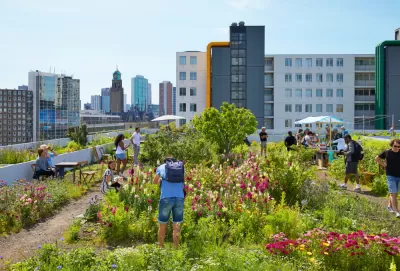What should urban planners reconsider when engaging in sustainable development?

City planners in the modern age are in one of the most exhilarating positions in history—to design projects for a sustainable future. The climate crisis is changing operations in every sector, but building projects are distinct because much of the process could shift due to global climate goals. What should urban planners reconsider when engaging in sustainable development?
Understanding the Urgency
Global temperatures will exceed sustainable levels in the coming years. Climate goals aren’t being achieved at the pace humanity needs to progress. Growing populations, industrialization, and international development require urban planning to reframe project trajectories. Planners have to construct them sustainably and assist with alleviating the climate crisis.
Dismissing the relevance of the climate crisis created vulnerable cities. Countless urban locations worldwide are susceptible to climate-influenced risks, including:
- Reduced citizen health and well-being
- Increased natural hazard severity, like drought or wildfire
- More radical temperature variances
- Inability to sustain increased population due to urban migration
Sustainable urban planning projects will create standards for future construction. Outlining precedents and priorities will simplify processes and decrease resistance against climate-focused city planning.
Preparing for Disasters
The goal is to have cities worldwide that are sturdy enough to handle generations of wear and tear—including human use and natural impact. Though sustainable urban planning intends to mitigate some of the effects of the climate crisis, the side effects of it will not dissipate immediately.
Therefore, cities must have an inherent resistance to the most intense elements humankind has ever experienced. Creating a building that can withstand hurricanes or tornadoes is a lofty goal, but it isn’t impossible.
Urban planners can consider communal infrastructure for safety and security. Making buildings safe for sheltering during natural disasters prepares citizens for the worst-case consequences of the climate crisis. It solidifies a city’s emergency management plan and ensures residents have access to clean water and air in thoughtfully constructed buildings made from sustainable yet durable materials.
It’s not just about having robust infrastructure—designing landscaping to supplement resiliency is paramount. Although trees assist in mitigating heat island effects and adverse respiratory ailments in larger cities, brittle or damaged ones with shallow roots can cause more damage during storms.
Installing Greener Cities
Keeping the climate crisis at the forefront of city planning projects is a worthwhile thesis, but how does execution look? Adaptability and independence are two overarching qualities of urban planning for the climate crisis.
Adaptive city planning will prevent flooding or high winds from damaging too much while acclimating to climate intensity and severity. It also reduces the fear of resource scarcity and provides healthier environments for residents. Finding a balance requires city planners to get creative while balancing citizens’ and sustainability needs.
A prepared city equates to a more economically viable city. Businesses seek locations for the long term—investing in a site in a climate-friendly town with healthy residents is a financial no-brainer. Areas with Internet of Things (IoT) technology to automate monitoring or that use renewable energy to cut down energy consumption and costs are more enticing.
City grids connect every infrastructure facet. For example, public transportation relies on telecommunications and energy and takes a hit if one system has an outage. Planning cities where each necessity can operate without assistance will make them more resilient and disrupt inhabitants’ lives and daily operations less frequently.
Urban Planning for a Greener Future
Some locations need restructuring from the ground up. Other cities are just beginning their development journey, but they’re blossoming from an existing environmentalist mentality. No two areas are the same for urban planners, but most places will eventually transform into embracing renewables, instilling ethical building practices and implementing technological aids for maintenance.
The future of city planning is one of the most impactful of the world’s sustainability initiatives, and its versatility and innovation will change the planet for the better.

Maui's Vacation Rental Debate Turns Ugly
Verbal attacks, misinformation campaigns and fistfights plague a high-stakes debate to convert thousands of vacation rentals into long-term housing.

Planetizen Federal Action Tracker
A weekly monitor of how Trump’s orders and actions are impacting planners and planning in America.

San Francisco Suspends Traffic Calming Amidst Record Deaths
Citing “a challenging fiscal landscape,” the city will cease the program on the heels of 42 traffic deaths, including 24 pedestrians.

Defunct Pittsburgh Power Plant to Become Residential Tower
A decommissioned steam heat plant will be redeveloped into almost 100 affordable housing units.

Trump Prompts Restructuring of Transportation Research Board in “Unprecedented Overreach”
The TRB has eliminated more than half of its committees including those focused on climate, equity, and cities.

Amtrak Rolls Out New Orleans to Alabama “Mardi Gras” Train
The new service will operate morning and evening departures between Mobile and New Orleans.
Urban Design for Planners 1: Software Tools
This six-course series explores essential urban design concepts using open source software and equips planners with the tools they need to participate fully in the urban design process.
Planning for Universal Design
Learn the tools for implementing Universal Design in planning regulations.
Heyer Gruel & Associates PA
JM Goldson LLC
Custer County Colorado
City of Camden Redevelopment Agency
City of Astoria
Transportation Research & Education Center (TREC) at Portland State University
Jefferson Parish Government
Camden Redevelopment Agency
City of Claremont



























